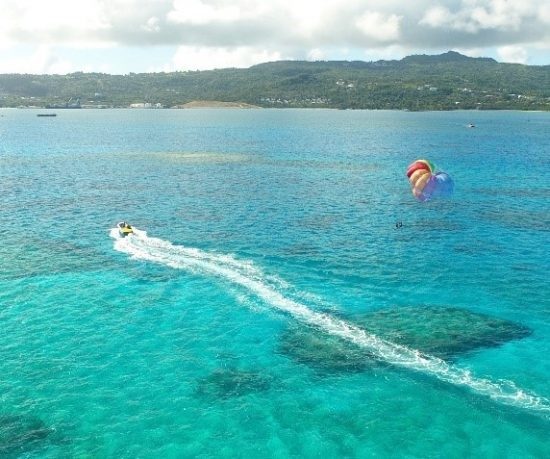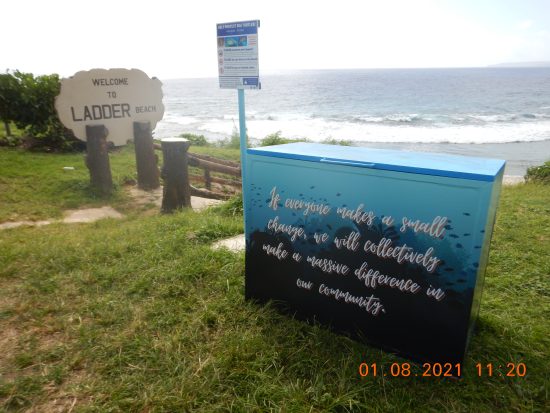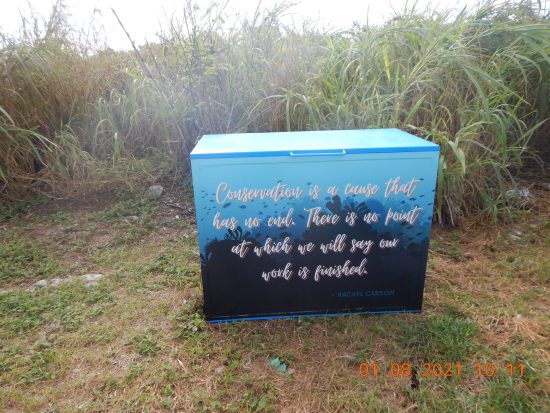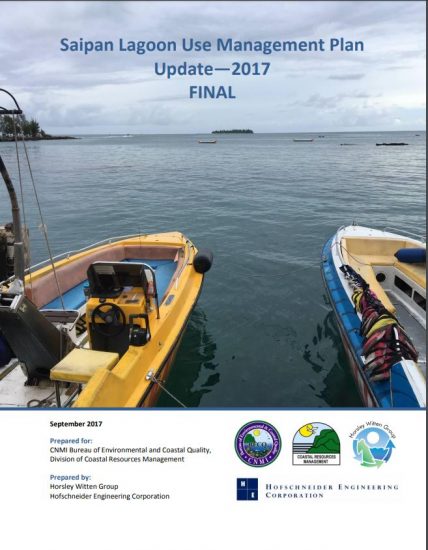Saipan Lagoon Use Management Planning

The Saipan Lagoon Use Management Plan (SLUMP) outlines a strategy for DCRM to follow as part of its mission to ensure both the sustainable use and environmental quality of the lagoon. The SLUMP identifies priority issues, key goals, and specific management actions that DCRM and its partners can pursue to improve the needs of a diverse set of users and stakeholders.
DCRM revises the SLUMP on a regular basis in order to adapt to changes in environmental and economic conditions and user groups. The SLUMP was first developed in 1985 and then updated in 1997, 2012, and 2017.
DCRM is working on addressing these recommendations through coastal zone planning and stakeholder engagement with key partner agencies.
As a result of the most recent (2017) SLUMP update, Lagoon management recommendations were provided to DCRM. These recommendations are as follows:
- Establish designated Lagoon use areas for motorized marine sports operations.
- Update DCRM marine sports permits.
- Minimize watershed impacts on corals in the northern Lagoon.
- Develop and implement a unified Lagoon user’s education plan.
- Collaborate with CUC on critical wastewater infrastructure improvements.
- Improve public access for Lagoon users.
- Encourage sustainable use of Mañagaha resources.
- Create a fishing safety equipment program.
- Continue to support BECQ’s marine monitoring program.
- Evaluate and implement appropriate shoreline stabilization and erosion control projects.
- Implement stormwater management improvements.
- Establish a sustainable, dedicated funding mechanism for Lagoon use management.
More information on these recommendations can be viewed here.
eco-tour operator best practices course (eco-to-bp)
 DCRM acknowledges that our marine sports operators (MSOs) and tour operators are critical stakeholders in managing our Lagoon and sustainable use of our land and ocean resources.
DCRM acknowledges that our marine sports operators (MSOs) and tour operators are critical stakeholders in managing our Lagoon and sustainable use of our land and ocean resources.
Prior to the pandemic, Saipan Lagoon and other valuable coastal visitor sites were experiencing degradation from littering, trampling of corals, and concerning safety issues.
In response, DCRM, MVA, and NMC have devised the Saipan Lagoon User Education Plan to inform how MSOs and tour operators could minimize their impact on our coastal resources. This intends to improve the water quality and health of the surrounding environments they work in while providing their visitors an amazing experience.
The Eco-Tour Operator Best Practices Course is DCRM’s approach to implementing the education plan. The course is at no cost to attendees and incentivizes permitted MSOs through a DCRM permit discount.
Check out the webpage here for more general information and how marine sports operators and tour guides can register!
living shorelines and nature-based solutions guidebook

On-going shoreline erosion plagues sections of Saipan’s sandy western coastlines, increasing risk of nearby recreational and hotel infrastructure to wave damage. Emerging from Recommendation #10: Evaluate and implement appropriate shoreline stabilization and erosion control projects, DCRM is developing the Living Shorelines and Nature-Based Solutions Guidebook to increase affected property owners and shoreline developers’ awareness on the benefits of utilizing green stabilization measures for addressing coastal erosion. Rather than reacting with shoreline hardening, they have the opportunity to enhance shoreline habitat and function for tackling shoreline erosion. The guide will also provide an array of stabilization methods and a road map on how to plan, permit, and implement projects. DCRM will be working with CNMI Forestry and other key stakeholders for review, feedback, and support on this effort.
This guide aims to inform local agencies as they may pursue federal grants for hazard mitigation, nature-based solutions and green infrastructure. This is a resource for the public and private sector who seek to address coastal erosion in the CNMI.
The guide is available here. Contact DCRM at shorelines@dcrm.gov.mp for the hard copy or for any inquiries.
2020 Saipan Lagoon User Education plan
Recognizing the necessity of building upon the momentum of the 2017 update, where user conflict and lagoon-use dominated the conversations, DCRM focused its efforts on Recommendation #4: Develop and Implement a Saipan Lagoon User Management Plan. Partnering with Marianas Visitors Authority (MVA), Northern Marianas College (NMC), and many other agencies, DCRM completed the Saipan Lagoon User Education Plan (SLUEP) in November 2020 with engagement from the Marine Sports Operator community. The SLUEP Workshop was held in November 17-18, 2020 at Kensington Hotel to increase MSO participation and improve the plan. To access the SLUEP, please click here.
Improved trash management
Trash accumulation is a persisting environmental issue at public areas, especially at frequently-visited beach sites. Under the SLUEP, trash management aligns with user education on marine debris. Using allocated funding from NOAA Office of Coastal Management, DCRM contributed 16 galvanized steel anti-litter bins to a handful of beaches, a percentage of which did not have pre-existing trash receptacles. Ten bins have been creatively painted by volunteer community members to inform the detrimental impacts of marine debris and advocate for a Plastic Free Marianas. The other six have been adorned with decals containing bold conservation quotes to encourage use. As part of the Bureau of Environmental Coastal Quality (BECQ), DCRM has the role of placing trash receptacles at public beaches pursuant to the Litter Control Act, 2 CMC § 3412. The Division of Parks and Recreation under the Department of Lands and Natural Resources (DLNR) has assumed responsibility of the these placed bins, which corresponds to their jurisdiction of maintaining litter containers and receptacles at all public beaches and parks. These bins were placed at the following locations: Laly 4, Aquarius, Civic Center, Quartermaster, 13 Fisherman, Micro Beach, Bird Island Lookout, Pau Pau Beach, Coral Ocean Point, Hidden Beach, Tank Beach, and Forbidden Island Lookout.


2017 Saipan Lagoon Use MaNagement Plan Update

In preparation for the most recent update, a Saipan Lagoon User Survey and Mapping project was conducted in 2016 to better understand the predominant uses of the lagoon as well as the particular areas where each activity tends to occur. A comprehensive State of the Lagoon report was developed to compile scientific studies, technical reports, and maps pertaining to the quality of lagoon resources, potential climate change and watershed threats, coastal dynamics, use conflicts, and past management priorities. A public forum comprised of four separate sessions was also held to present data on the current conditions of the lagoon, solicit stakeholder input, and develop priority action areas and initial implementation options. A summary of these activities and studies are included as appendices to the full report.
Visit this website for more information on the 2017 SLUMP update.
See the list of publications below for more information:
- Saipan Lagoon Maps
- Saipan Lagoon User Survey and Mapping project (2016)
- Saipan Lagoon Use – Mapping Tool (DCRM)
- Three Dimensional Wave-Current Hydrodynamic Model for the Management of Saipan Lagoon (2010)
- Saipan’s Misbehaving Beaches Map (2014)
- Shoreline Access in the Commonwealth of the Northern Mariana Islands Map
- CNMI Climate Impact Viewer
- Assessing relative resilience potential of coral reefs to inform management (Maynard et al., 2015)
- Groundwater Resources of Saipan, Commonwealth of the Northern Mariana Islands (USGS, 2003)
